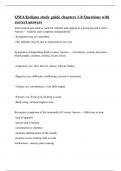College aantekeningen
Actors in World Politics Lectures Notes (Lectures 2-5, 7-12) - GRADE 7,5
- Instelling
- Universiteit Leiden (UL)
Notes on the lectures from the course (2021) Actors in World Politics. INCLUDES lectures 2-5, 7-12 (Total: 26 pages).
[Meer zien]













